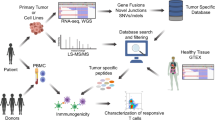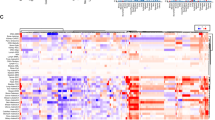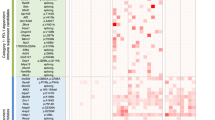Abstract
Cancer immunoediting, the process by which the immune system controls tumour outgrowth and shapes tumour immunogenicity, is comprised of three phases: elimination, equilibrium and escape1,2,3,4,5. Although many immune components that participate in this process are known, its underlying mechanisms remain poorly defined. A central tenet of cancer immunoediting is that T-cell recognition of tumour antigens drives the immunological destruction or sculpting of a developing cancer. However, our current understanding of tumour antigens comes largely from analyses of cancers that develop in immunocompetent hosts and thus may have already been edited. Little is known about the antigens expressed in nascent tumour cells, whether they are sufficient to induce protective antitumour immune responses or whether their expression is modulated by the immune system. Here, using massively parallel sequencing, we characterize expressed mutations in highly immunogenic methylcholanthrene-induced sarcomas derived from immunodeficient Rag2−/− mice that phenotypically resemble nascent primary tumour cells1,3,5. Using class I prediction algorithms, we identify mutant spectrin-β2 as a potential rejection antigen of the d42m1 sarcoma and validate this prediction by conventional antigen expression cloning and detection. We also demonstrate that cancer immunoediting of d42m1 occurs via a T-cell-dependent immunoselection process that promotes outgrowth of pre-existing tumour cell clones lacking highly antigenic mutant spectrin-β2 and other potential strong antigens. These results demonstrate that the strong immunogenicity of an unedited tumour can be ascribed to expression of highly antigenic mutant proteins and show that outgrowth of tumour cells that lack these strong antigens via a T-cell-dependent immunoselection process represents one mechanism of cancer immunoediting.
This is a preview of subscription content, access via your institution
Access options
Subscribe to this journal
Receive 51 print issues and online access
$199.00 per year
only $3.90 per issue
Buy this article
- Purchase on SpringerLink
- Instant access to full article PDF
Prices may be subject to local taxes which are calculated during checkout




Similar content being viewed by others
References
Shankaran, V. et al. IFNγ and lymphocytes prevent primary tumour development and shape tumour immunogenicity. Nature 410, 1107–1111 (2001)
Dunn, G. P., Bruce, A. T., Ikeda, H., Old, L. J. & Schreiber, R. D. Cancer immunoediting: from immunosurveillance to tumor escape. Nature Immunol. 3, 991–998 (2002)
Koebel, C. M. et al. Adaptive immunity maintains occult cancer in an equilibrium state. Nature 450, 903–907 (2007)
Vesely, M. D., Kershaw, M. H., Schreiber, R. D. & Smyth, M. J. Natural innate and adaptive immunity to cancer. Annu. Rev. Immunol. 29, 235–271 (2011)
Schreiber, R. D., Old, L. J. & Smyth, M. J. Cancer immunoediting: integrating immunity’s roles in cancer suppression and promotion. Science 331, 1565–1570 (2011)
Futreal, P. A. et al. A census of human cancer genes. Nature Rev. Cancer 4, 177–183 (2004)
Chen, A. C. & Herschman, H. R. Tumorigenic methylcholanthrene transformants of C3H/10T1/2 cells have a common nucleotide alteration in the c-Ki-ras gene. Proc. Natl Acad. Sci. USA 86, 1608–1611 (1989)
Tuveson, D. A. et al. Endogenous oncogenic K-ras(G12D) stimulates proliferation and widespread neoplastic and developmental defects. Cancer Cell 5, 375–387 (2004)
Kirsch, D. G. et al. A spatially and temporally restricted mouse model of soft tissue sarcoma. Nature Med. 13, 992–997 (2007)
Ley, T. J. et al. DNA sequencing of a cytogenetically normal acute myeloid leukaemia genome. Nature 456, 66–72 (2008)
Ding, L. et al. Genome remodelling in a basal-like breast cancer metastasis and xenograft. Nature 464, 999–1005 (2010)
Shah, S. P. et al. Mutational evolution in a lobular breast tumour profiled at single nucleotide resolution. Nature 461, 809–813 (2009)
Lee, W. et al. The mutation spectrum revealed by paired genome sequences from a lung cancer patient. Nature 465, 473–477 (2010)
Pleasance, E. D. et al. A small-cell lung cancer genome with complex signatures of tobacco exposure. Nature 463, 184–190 (2010)
Totoki, Y. et al. High-resolution characterization of a hepatocellular carcinoma genome. Nature Genet. 43, 464–469 (2011)
Puente, X. S. et al. Whole-genome sequencing identifies recurrent mutations in chronic lymphocytic leukaemia. Nature 475, 101–105 (2011)
Pleasance, E. D. et al. A comprehensive catalogue of somatic mutations from a human cancer genome. Nature 463, 191–196 (2010)
Boon, T., Coulie, P. G., Van den Eynde, B. J. & van der Bruggen, P. Human T cell responses against melanoma. Annu. Rev. Immunol. 24, 175–208 (2006)
Segal, N. H. et al. Epitope landscape in breast and colorectal cancer. Cancer Res. 68, 889–892 (2008)
Nielsen, M. et al. Reliable prediction of T-cell epitopes using neural networks with novel sequence representations. Protein Sci. 12, 1007–1017 (2003)
van der Bruggen, P. et al. A gene encoding an antigen recognized by cytolytic T lymphocytes on a human melanoma. Science 254, 1643–1647 (1991)
Khong, H. T. & Restifo, N. P. Natural selection of tumor variants in the generation of “tumor escape” phenotypes. Nature Immunol. 3, 999–1005 (2002)
Dunn, G. P., Old, L. J. & Schreiber, R. D. The three Es of cancer immunoediting. Annu. Rev. Immunol. 22, 329–360 (2004)
DuPage, M., Mazumdar, C., Schmidt, L. M., Cheung, A. F. & Jacks, T. Expression of tumour-specific antigens underlies cancer immunoediting. Nature doi:10.1038/nature10803 (this issue).
Yewdell, J. W. Confronting complexity: real-world immunodominance in antiviral CD8+ T cell responses. Immunity 25, 533–543 (2006)
Prehn, R. T. & Main, J. M. Immunity to methylcholanthrene-induced sarcomas. J. Natl. Cancer Inst. 18, 769–778 (1957)
Old, L. J. & Boyse, E. A. Immunology of experimental tumors. Annu. Rev. Med. 15, 167–186 (1964)
Huang, S. et al. Immune response in mice that lack the interferon-γ receptor. Science 259, 1742–1745 (1993)
Muller, U. et al. Functional role of type I and type II interferons in antiviral defense. Science 264, 1918–1921 (1994)
Li, H. & Durbin, R. Fast and accurate short read alignment with Burrows–Wheeler transform. Bioinformatics 25, 1754–1760 (2009)
Koboldt, D. C. et al. VarScan: variant detection in massively parallel sequencing of individual and pooled samples. Bioinformatics 25, 2283–2285 (2009)
Ning, Z., Cox, A. J. & Mullikin, J. C. SSAHA: a fast search method for large DNA databases. Genome Res. 11, 1725–1729 (2001)
Li, H. et al. The Sequence Alignment/Map format and SAMtools. Bioinformatics 25, 2078–2079 (2009)
Robinson, J. T. et al. Integrative genomics viewer. Nature Biotechnol. 29, 24–26 (2011)
Felsenstein, J. Phylogeny Inference Package. Cladistics 5, 164–166 (1989)
Ranganath, S. et al. GATA-3-dependent enhancer activity in IL-4 gene regulation. J. Immunol. 161, 3822–3826 (1998)
Dighe, A. S., Richards, E., Old, L. J. & Schreiber, R. D. Enhanced in vivo growth and resistance to rejection of tumor cells expressing dominant negative IFNγ receptors. Immunity 1, 447–456 (1994)
Acknowledgements
We are grateful to J. Archambault for expert technical assistance, T. H. Hansen (Washington University) for providing MHC class I antibodies, S. Horvath and P. M. Allen (Washington University) for synthesizing MHC class I peptides, the National Institutes of Health (NIH) Tetramer Core Facility for producing MHC class I tetramers, and T. S. Stappenbeck (Washington University) for technical help in recovering frozen tumour samples. We also thank E. Unanue, P. M. Allen and J. Bui for criticisms and comments, all members of the Schreiber laboratory for discussions, and the many members of The Genome Institute at Washington University School of Medicine, especially L. Ding for her insights into our analytical approaches. This work was supported by grants to R.D.S. from the National Cancer Institute, the Ludwig Institute for Cancer Research, the Cancer Research Institute, and the WWW.W Foundation; and to E.R.M. from the National Human Genome Research Institute. M.D.V. is supported by a pre-doctoral fellowship from the Cancer Research Institute. J.P.A. is supported by the Howard Hughes Medical Institute and the Ludwig Center for Cancer Immunotherapy; M.J.S. by the National Health and Medical Research Council of Australia (NH&MRC) and from the Association for International Cancer Research; and L.J.O. by the Ludwig Institute for Cancer Research and the Cancer Research Institute.
Author information
Authors and Affiliations
Contributions
H.M. and M.D.V. were involved in all aspects of this study including planning and performing experiments, analysing and interpreting data, and writing the manuscript. C.G.R., R.U., C.D.A., J.M.W., Y.-S.C. and L.K.S. also performed experiments and analysed data. V.J.M., R.D. and members of The Genome Institute performed Illumina library preparation, cDNA capture and sequencing as well as validation Roche/454 pyrosequencing and 3730 sequencing. D.C.K. analysed and interpreted sequencing data from this study and previously published cancer genome data. J.H. and T.W. analysed cDNA CapSeq data for potential MHC class I epitopes. M.C.W. performed the phylogenetic analysis on the tumour cells. J.P.A., M.J.S. and L.J.O. interpreted data and contributed to the preparation of the final manuscript. E.R.M. and R.D.S oversaw all the work performed, planned experiments, interpreted data and wrote the manuscript.
Corresponding author
Ethics declarations
Competing interests
The authors declare no competing financial interests.
Supplementary information
Supplementary Information
This file contains: 1 Supplementary Figures 1-11 with legends, which include supporting experiments demonstrating the immunogenic behavior of H31m1 and d42m1, that mutant spectrin-β2 is the major rejection antigen of d42m1 sarcoma cells, that spectrin-β2 is not epigenetically silenced, and that escape tumours of d42m1 emerge via an immunoselection process that favors outgrowth of cells lacking mutant spectrin-β2; and 2 Supplementary Table 5, which lists both wild type and mutant epitopes predicted by Immune Epitope Database and Analysis Resource for misssense mutations that are present in d42m1 regressor tumours (d42m1 parental, d42m1-T1, d42m1-T2, and d42m1-T9) and absent in d42m1 progressor tumours (d42m1-T3, d42m1-T10, d42m1-es1, d42m1-es2, and d42m1-es3) - see separate files for Supplementary Tables 1-4. (PDF 1461 kb)
Supplementary Table 1
This table lists all the single nucleotide variants (SNVs) for H31m1 and the d42m1 tumour tumours as detected by cDNA capture sequencing. These include missense, nonsense, nonstop, splice site, silent, and RNA gene mutations. (XLS 4994 kb)
Supplementary Table 2
This table compares all the missense mutations in H31m1 and d42m1 parental tumour cells. Missense mutations are organized as either shared between H31m1 and d42m1 or unique to each individual sarcoma cell line. (XLS 1072 kb)
Supplementary Table 3
This table lists all the mutated genes in H31m1 and d42m1 parental tumour cells and whether these genes are among the list of known human cancer genes (Cancer Gene Census; http://www.sanger.ac.uk/genetics/CGP/Census/). (XLS 261 kb)
Supplementary Table 4
This table lists validation sequencing by Roche/454 pyrosequencing and Applied Biosystems/3730 sequencing in tumour cells and normal cells and lists the primer sets used for this analysis. (XLS 53 kb)
Rights and permissions
About this article
Cite this article
Matsushita, H., Vesely, M., Koboldt, D. et al. Cancer exome analysis reveals a T-cell-dependent mechanism of cancer immunoediting. Nature 482, 400–404 (2012). https://doi.org/10.1038/nature10755
Received:
Accepted:
Published:
Issue Date:
DOI: https://doi.org/10.1038/nature10755
This article is cited by
-
Breakthrough of solid tumor treatment: CAR-NK immunotherapy
Cell Death Discovery (2024)
-
Overcoming acquired resistance to cancer immune checkpoint therapy: potential strategies based on molecular mechanisms
Cell & Bioscience (2023)
-
Advanced immunotherapies for glioblastoma: tumor neoantigen vaccines in combination with immunomodulators
Acta Neuropathologica Communications (2023)
-
Oncogenic drivers dictate immune control of acute myeloid leukemia
Nature Communications (2023)
-
Characterization of pancreatic cancer with ultra-low tumor mutational burden
Scientific Reports (2023)



